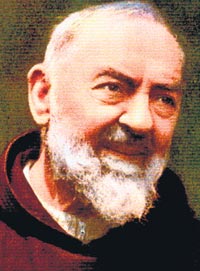
Lanka honours Saint Padre Pio with first-ever shrine in AsiaThe Italian priest Saint Pio of Pietrelcina, popularly known as Padre Pio was born in 1887 and died in 1968. He was the only priest in the history of the Catholic Church to bear the stigmata – physical wounds like those suffered by Jesus Christ. He bore the painful wounds for a full 50 years.
In Sri Lanka, the first ever shrine in honour of the much loved St. Pio will be solemnly blessed and dedicated by the Archbishop of Colombo, the Most Rev. Dr. Oswald Gomis at Athurugiriya today– the Feast Day of the saint. Perhaps, this may be the first shrine and reconciliation centre to be constructed in honour of St. Pio in all of Asia. Like all divine works, the shrine at Athurugiriya began in a small way and progressed steadily in spite of tribulations. But, how did it all happen? The Archdiocese of Colombo launched a project to collect finances on a novel idea styled, “Give us a million cents and be a partner in our project,” spearheaded by Rev. Fr. Bertram Dabrera in his capacity as the Project Director. This was consequent to a request made to then Archbishop of Colombo, the Most Rev. Dr. Nicholas Marcus Fernando by an American Mario Bruski to erect a shrine in honour of the saint in Sri Lanka. Rev. Fr. Kingsley Jayamanne, the Vicar General got the consent of the parish community to build the shrine at Athurugiriya and the foundation stone was laid on September 23, 2004. The herculean task of obtaining required approvals for erection of the shrine as well as finalizing architectural designs and implementation of the project was left in the safe hands of Rev. Fr. Bertram Dabrera, the renowned church builder. It was Fr. Bertram Dabrera who built Our Lady Queen of Peace Church at Maligawatte. Rev. Fr. Kingsley Jayamanne was appointed the Director of Finance whilst Gamini Kannangara functioned as the Director Co-ordinating. They were ably supported by the Building Committee. Let's hope that this magnificent shrine will be yet another rallying point of Catholics and a great national sanctuary in the years ahead. St. Padre Pio was born to Grazio Mario Forgione (1860 - 1946) and Maria Giuseppa de Nunzio Forgione (1859 - 1929) on May 25, 1887 in Pietrelcina, a town in Southern Italy. Even as a young boy, he showed signs of extraordinary gifts of grace. When he was 15, he entered the Novitiate of the Capuchin Order of the Friars Minor in Morcone. On January 22, 1903 he took the Franciscan habit and the name of Friar (Brother) Pio in honour of Pope Saint Pius V, the Patron Saint of Pietrelcina. He took the simple vows of poverty, chastity and obedience. To commence his six-year study for priesthood he joined the Friary of St. Francis of Assisi. On August 10, 1910, at the age of 23, Brother Pio was ordained a priest. The celebration of the Holy Mass was the centre of his spirituality. Due to the long pauses of contemplative silence into which he entered at various parts of the Holy Sacrifice, his mass sometimes lasted hours. When asked to shorten his mass, Padre Pio replied, "God knows that I want to say mass just like any other priest, but I cannot do it." He was intensely living the Passion of Christ. Padre Pio had five rules for spiritual growth - weekly confession, daily Communion, spiritual reading, meditation and examination of conscience. He compared weekly confession to dusting a room weekly, and recommended the performance of meditation and self-examination twice daily: once in the morning, as preparation to face the day, and once again in the evening, as retrospection. His advice on the practical application of theology he often summed up in his now famous quote, “Pray, hope and don’t worry”. He directed Christians to recognize God in all things and to desire above all things to do the will of God. On Friday September 20, 1918, Padre Pio was in profound peace and had a vision in which the Wounded Christ, appeared. He had an experience of religious ecstasy. When it ended, Padre Pio had received the Visible Stigmata - bodily marks, pain, and bleeding in locations corresponding to the crucifixion wounds of Jesus Christ. The stigmata was permanent and would stay on him for the next 50 years of his earthly life. The blood flowing from the stigmata is said to have smelled of perfume or flowers, a phenomenon mentioned in stories of the lives of several saints and known as the odour of sanctity. The observations reportedly were unexplainable and the wounds never infected. It was reputed, however, that his condition caused him great embarrassment, and most photographs show him with black coverings on his hands and feet where the bleedings occurred. In 1990 Padre Pio was declared a Servant of God - the first step in the progression to canonization. In 1997 Pope John Paul II declared him Venerable and in 1999 on the advice of the Congregation, John Paul II declared Padre Pio Blessed. In one of the largest liturgies in the Vatican's history, Pope John Paul II canonized Padre Pio on June 16, 2002. |
|| Front
Page | News | Editorial | Columns | Sports | Plus | Financial
Times | International | Mirror | TV
Times | Funday
Times || |
| |
Reproduction of articles permitted when used without any alterations to contents and the source. |
© Copyright
2007 Wijeya
Newspapers Ltd.Colombo. Sri Lanka. All Rights Reserved. |
